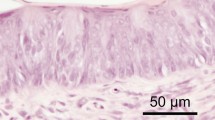Abstract
Immunohistochemical analysis demonstrated that lens cells of the laboratory house shrew, Suncus murinus, expressed many intracellular filaments that immunoreacted with pooled monoclonal antibodies against 70-kDa, 160-kDa, and 210-kDa neurofilament triplet proteins. Immunopositive filaments in lens cells first appeared in day 13 embryos, while the invaginating lens placode was thickening, and this immunoreactivity was still present in immature lens fiber cells of the adult animal. Western blot analysis showed that the immunopositive molecule was a low-molecular-weight neurofilament protein that appeared in the neural tissues of this animal. The immunoreactive pattern of lens cells was quite similar to that of neurons, although there were some peculiar aspects. When the cells of the lens vesicle differentiated into the lens epithelium and fibers, immunoreactivity occurred in both, suggesting that the neurofilaments in the lens cells do not directly relate to lens fiber elongation nor to a determinant of the fiber caliber. The strong immunoreactivity in the embryonic lens and weak expression of this protein in the immature lens fiber cells of the adult animal suggest that low-molecular-weight neurofilament protein is transiently expressed in the differentiating lens cells. This may be a common feature of placodederived cells.
Similar content being viewed by others
References
Bennett GJ, DiLullo C (1985) Transient expression of a neurofilament protein by replicating neuroepithelial cells of the embryonic chick brain. Dev Biol 107:107–127
Bossy J (1980) Development of olfactory and related structures in staged human embryos. Anat Embryol 161:225–236
Bradley RH, Ireland M, Maisel H (1979) The cytoskeleton of chick lens cells. Exp Eye Res 28:441–453
D'Amico-Martel A, Noden DM (1983) Contributions of placodal and neural crest cells to avian cranial peripheral ganglia. Am J Anat 166:445–468
Ellis M, Alousi S, Lawniczak J, Maisel H, Welsh M (1984) Studies on lens vimentin. Exp Eye Res 38:195–202
Fitzgerald PG, Graham D (1991) Ultrastructural localization of αA-crystallin to the bovine lens fiber cell cytoskeleton. Curr Eye Res 10:417–436
Ireland M, Maisel H (1984) A cytoskeletal protein unique to lens fiber cell differentiation. Exp Eye Res 38:637–645
Kaplan MP, Chin SSM, Fliegner KH, Liem KH (1990) α-internexin, a novel neuronal intermediate filament protein, precedes the low molecular weight neurofilament protein (NF-L) in the developing rat brain. J Neurosci 10:2735–2748
Laemmli UK (1970) Cleavage ot structural proteins during the assembly of the head of bacteriophage T4. Nature 227:680–685
Lasek RJ, Oblinger MM, Drake PF (1983) The molecular biology of neuronal geometry: the expression of neurofilament genes influences axonal diameter. Cold Spring Harb Symp Quant Biol 48:431–444
Le Douarin N (1982) The neural crest. Cambridge University Press, Cambridge
Lewis SA, Cowan NJ (1985) Genetics, evolution, and expression of the 68,000-mol-wt neurofilament protein: isolation of a cloned cDNA probe. J Cell Biol 100:843–850
Lieska N, Shao D, Kroho V, Yang H-Y (1991) Expression and distribution of cytoskeletal IFAP-300kD as an index of lens cell differentiation. Curr Eye Res 10:1165–1174
Napolitano EW, Chin SSM, Colman DR, Liem RKH (1987) Complete amino acid sequence and in vitro expression of rat NF-M, the middle molecular weight neurofilament protein. J Neurosci:2590–2599
Oda S (1985) Management, keeping and breeding. In: Kondo K, Oda S, Kito J, Ota K, Isomura G (eds) Suncus murinus, biology of Soricidae, Insectivora as an experimental animal (in Japanese). Japan Scientific Society Press, Tokyo, pp 102–111
Phillips LL, Autilio-Gambetti L, Lasek RJ (1983) Bodian's silver method reveals molecular variantion in the evolution of neurofilament proteins. Brain Res 278:219–223
Sharpe CR, Pluck A, Gurdon JB (1989) XIF3, a Xenopus peripherin gene, requires an inductive signal for enhanced expression in anterior neural tissue. Development 107:701–714
Shaw G, Weber K (1982) Differential expression of neurofilament triplet proteins in brain development. Nature 298:277–279
Steinert PM (1985) Intermediate filaments: conformity and diversity of expression and structure. Annu Rev Cell Biol 1:41–65
Steinert PM, Roop DR (1988) Molecular and cellular biology of intermediate filaments. Annu Rev Biochem 57:593–625
Takeichi M (1988) The cadherin: cell-cell adhesion molecules controlling animal morphogenesis. Development 102:639–655
Verwoerd CDA, Oostrom CG van (1979) Cephalic neural crest and placodes. Adv Anat Embryol Cell Biol 58:1–75
Yasui K (1992) Embryonic development of the house shrew (Suncus murinus). I. Embryos at stages 9 and 10 with 1 to 12 pairs of somites. Anat Embryol 186:49–65
Author information
Authors and Affiliations
Rights and permissions
About this article
Cite this article
Yasui, K., Agata, K. & Tanaka, S. Neurofilament expression in lens cells of the house shrew, Suncus murinus . Anat Embryol 189, 401–407 (1994). https://doi.org/10.1007/BF00185435
Accepted:
Issue Date:
DOI: https://doi.org/10.1007/BF00185435




